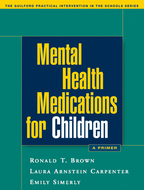Mental Health Medications for Children
A Primer
Ronald T. Brown, Laura Arnstein Carpenter, and Emily Simerly
This title is part of The Guilford Practical Intervention in the Schools Series, edited by Sandra M. Chafouleas.
“Ron Brown has done it again! This helpful text presents succinct information regarding medications frequently prescribed to the pediatric population. It is an excellent reference for the busy school practitioner who provides instruction, counseling, or support services to children receiving psychotropic medications. The authors promote interdisciplinary collaboration and stress the importance of school personnel participating actively in treatment planning and monitoring. I heartily recommend this book to teachers, school counselors, school administrators, and all others who interact to ensure the successful psychoeducational development of youth who require psychotropic interventions.”
—LeAdelle Phelps, PhD, School Psychology Program, University at Buffalo, State University of New York.
“Once again, Dr. Brown and his colleagues take a complex topic and make it appear simple without being simplistic. This book is an essential addition to the resource shelf in every school. The authors do an admirable job of sharing critical information about medication and explaining how school personnel interface with children, parents, and mental health treatment providers in regard to medication use. Myths about medication are dispelled, figures and tables summarize pertinent facts, and case examples illuminate the myriad issues involved. Sensitive, thorough, and pragmatic.”
—Mary A. Fristad, PhD, Division of Child and Adolescent Psychiatry, The Ohio State University
“This impressive new book is a 'must-have' resource for school professionals and professionals-in-training, and would be of substantial benefit to psychologists and physicians who interface with schools in the treatment of child psychiatric disorders. In addition to providing a wealth of information on psychotropic medications and their use with children, it emphasizes the role of school professionals on the treatment team and offers practical strategies to facilitate a team approach. Written in a clear and understandable style, this book is comprehensive, empirically solid, and highly practical. In one reader-friendly volume, the authors provide substantial information about psychotropic medications for children, emphasize teamwork, and promote safe and effective practice.”
—Cheryl A. King, PhD, Department of Psychiatry, University of Michigan Medical School
“This book is well written and well informed. Dr. Brown and colleagues take a very complex subject and simplify it for an audience of nonmedical, nonpharmacist professionals. It is not easy to accomplish such a task and retain a truly representative picture of current practice. I will recommend this book to my nonmedical colleagues who work with children.”
—James Beeghly, MD, Department of Psychiatry, University of Iowa Hospitals and Clinics
“An outstanding and very much-needed resource for school professionals. As the number of youngsters on psychoactive medication continues to rise, school psychologists, teachers, nurses, and administrators play an ever more prominent role as members of child mental health treatment teams. This book provides an excellent and up-to-date overview of child psychiatric problems and associated medication strategies, including clear guidelines for how school personnel can most effectively contribute to the mental health treatment of their students. Written in an easily understandable and user-friendly style, this is essential reading for those working in both regular and special education settings, as well as for those still in training.”
—John Piacentini, PhD, Child OCD, Anxiety, and Tic Disorders Program, University of California, Los Angeles
Table of Contents
1. Overview and Pediatric Psychopharmacology Practices2. The Importance of School Personnel on the Treatment Team
3. Classifications of Psychotropic Medications
4. Child Psychiatric Disorders and Psychotropic Medications
5. Medication Effectiveness and Side Effects
6. Conclusion
Glossary
Appendices
Appendix 1. Common Mental Health Medications for Children
Appendix 2. Event Observation Log
Appendix 3. Letter to Physician
Appendix 4. Ranking Problem Behaviors
Appendix 5. Proper Handling Procedures for Medications for Children
Appendix 6. Medication Initiation Form
Appendix 7. Authorization to Administer Medication
Appendix 8. Monthly Medication Log
Appendix 9. Medication Contract
Appendix 10. FDA Black Box Warnings for Antidepressants
Appendix 11. Behavior Observation Form 1: Event Recording
Appendix 12. Behavior Observation Form 2: Duration Recording
Appendix 13. Behavior Observation Form 3: Total Duration Recording
Appendix 14. Line Graph 1: Less Frequent Behaviors
Appendix 15. Line Graph 2: More Frequent Behaviors and Percentages
Appendix 16. Side Effects
About the Authors
Ronald T. Brown, PhD, is Professor of Public Health, Pediatrics, and Psychology, and Dean of the College of Health Professions at Temple University. Currently editor of the Journal of Pediatric Psychology, he has published several books and over 200 articles and chapters in the areas of pediatric psychology and pediatric psychopharmacology. Dr. Brown was formerly President of the Society for Pediatric Psychology and currently serves the National Institutes of Health, Center for Scientific Review, study section on behavioral medicine interventions and outcomes. He is a diplomate in Clinical Health Psychology of the American Board of Professional Psychology and a fellow in the American Psychological Association, the American Psychological Society, and the National Academy of Neuropsychology.Laura Arnstein Carpenter, PhD, is Assistant Professor of Pediatrics at the Medical University of South Carolina. Dr. Carpenter is a licensed clinical psychologist specializing in the assessment and treatment of autism spectrum disorders, and has extensive training and clinical experience in pediatric neuropsychology. She has cowritten nine articles and chapters, and has made more than 30 presentations at regional and national scientific conferences.
Emily Simerly, PhD, is Clinical Director of the Mental Health Unit at the Georgia Diagnostic and Classification Prison in Jackson, Georgia, a maximum security men's intake prison that also houses Death Row. She is also Regional Clinical Director of mental health units at a number of prisons in northern Georgia. Dr. Simerly has published articles in Voices and has written a chapter in Psychotherapy and the Poverty Patient. As a clinician, she uses a humanistic–existential foundation to practice in-depth psychotherapy, using many cognitive-behavioral techniques.
